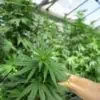TABLE OF CONTENTS
Cannabis is a plant that enjoys mild climates. It thrives in sunny, warm environments and responds negatively to temperatures that dip too low.
Low temperatures can pose challenges for those who want to grow marijuana year-round and want to produce a significant winter crop. Growing cannabis during the colder months may call for a little extra knowledge on heating your cannabis grow.
Outdoor vs Indoor Settings
Outdoor cultivators experience the most significant obstacles to growing cold-weather cannabis since crops are exposed to the harsh winter climate. In the United States’ temperate climate, only the warmest regions can attempt an outdoor grow during winter’s short, cold days.
In cold-climate regions, outdoor growers risk ending up with a lackluster harvest. Even cultivators in the warmest temperate regions must choose their strains and overall operations plan wisely.
Even a greenhouse grower will experience unique challenges relating to reduced daylight and temperatures during the winter. Indoor growers have the luxury of seamless and continuous production year-round because their controlled indoor climate never varies regardless of the calendar date and outdoor weather.
The home grower and indoor commercial cultivator may pay more for heating and electricity during the winter. Still, their operations will continue without so much as a hiccup even if it is freezing cold outside..
If you want to grow cannabis in the cold, don’t fret. There are effective ways to overcome the limitation of the winter months. Let’s examine the various strategies that cultivators can employ in a variety of growing environments to keep plants warm in the winter. Each method poses its unique challenges and solutions.
Cold-Hardy Strains
The success of a cannabis garden depends considerably on the quality of its genetics. If you want to grow weed during the cold weather months, you have the best chance of getting a bountiful yield with big buds by choosing cannabis strains that can withstand cold weather, particularly indica and autoflowering strains.
For best results, choose cannabis strains that evolved in cooler regions of the world. Pure indicas, also known as landrace strains, from the mountains of Pakistan and Afghanistan and indica-dominant strains grow much better in cold weather regions than sativa and sativa-dominant strains that prefer warmer weather.
The best indica and indica-dominant strains for cold-weather cultivation include:
- Super Skunk
- Northern Lights
- Blackberry
- Durban Poison
- Critical
- Afghan Kush
- LSD
- Blue Cheese
Autoflowering strains are also good options for growers who want cold-hardy plants. Cannabis Ruderalis is a cannabis variety that automatically flowers after a certain period of time instead of waiting for the light cycle to change like photoperiod plants. The automatic flowering cycle allows growers to grow cannabis in a relatively fast time period.
Autoflowering strains originated in Central/Eastern Europe and Russia, so they are able to handle slightly cooler weather than most photoperiod strains.
Best of all, they can be ready to be harvested in just eight weeks after planting the seeds. For this reason, they are popular with growers who want to grow multiple harvests in a single season, especially during cooler months.

Ideal Growing Temperatures
Cannabis has fairly rigid needs when it comes to growing temperatures. It needs to be at a moderate temperature for optimal health.
Humidity is also an important factor in its growth, but mainly in environments where the outdoor ambient humidity is too high. The temperatures in which cannabis grows the best vary slightly during various stages of growth, but the differences aren’t too extreme.
Marijuana plants do not respond well to temperatures that are either too warm or too cold. Throughout most of their lives, the plants will do very well in the 70-85°F range. Temperatures that fall below 60°F or above 95°F can stress the plants and cause them to grow slower—or at least less than an optimum growth rate.
Temperatures that dip to the freezing level can kill a healthy cannabis plant. Conversely, temperatures that rise above 95°F will result in stressed plants that grow slower and have drooping or cupped leaves.
Plants grown in temperatures that are too low or high are more susceptible to various diseases and pests that commonly impact cannabis, especially in environments with overly high humidity. Ailments such as white powdery mildew, spider mites, mold, and root rot are more likely to occur under these extreme conditions.
Prudent cannabis growers will prevent large temperature fluctuations. They do so by maintaining the perfect temperature depending on the stage of the plants’ development.
Each stage of plant growth has ideal conditions that will allow the plant to reach its full potential. The risks associated with improper temperatures either indoors or outdoors are by no means limited to those mentioned above.
When growing cold-weather cannabis, there can be some severe drawbacks if low temperatures go unchecked. At temperatures of 55°F or lower, trichome development stops and overall potency goes down. Since high potency is the desired result of every grower, overly cool temperatures can result in low-quality flower buds.
During the seedling (or small clone) stage of growth, young cannabis plants enjoy an ideal temperature range of 68-77°F. When their root systems are still developing at this early age, seedlings will also appreciate slightly higher humidity than at any other stage of their growth. Humidity levels of 65-70% are just about right.
During the later stages of vegetative growth, the ideal temperature range rises slightly to 71-82°F, and humidity requirements will decrease approximately 5% per week and fall between 40-65%. In the flowering stage of growth, the ideal temperature will fall to 70-78°F. These temperature fluctuations simulate what a cannabis plant growing outside will experience during the spring, summer, and fall months.
Insulation for Heating Your Cannabis Grow
Insulation requirements for indoor growers will depend on the location of the grow space. Grow rooms in bedrooms, for instance, may not require extra insulation since the original construction and insulation is enough.
If the grow room is located in a garage or a building outdoors, you may need to think about investing in additional insulation to keep your plants warm during the winter, especially if you live in climates with excessive cold weather such as the Midwest and east coast of the U.S.
Ideally, insulating a grow tent can be the most cost-effective method since you do not have to insulate the entire space, just the growing tent within the room. When shopping for the best grow tents, look for a sturdy and durable grow tent for best results.
If you want to insulate the room you will be growing in, consider high-quality spray foam, which seeps into every open crevice in your walls. However, this material requires a high upfront investment but can pay for itself in the long run.
Bright, white PVC wall panels are another popular option for professional grow spaces. Not only do they provide insulation, but they are long-lasting and highly reflective, which help increase the efficiency of your lights.
Heaters and Heat Lamps
If necessary, invest in a small space heater or heat lamps, just make sure to not overheat the room or place them next to flammable materials. Excessive heat can end up drying your plants and burning the foliage. If using a heater, check the moisture levels in your soil to ensure it is getting enough water.
Cold Floor Solutions
Placing your cannabis plant directly on a cold floor such as concrete can affect its rate of growth and quality of yield. If using a grow tent, consider placing it on carpet or on any other insulating material to avoid it being directly on the cold floor. If necessary, raise your pot and tray off of the ground.
Essentially, you want to keep the roots away from the cold floor. Soil-heating mats are traditionally used for germination but can also be placed under trays and pots to add additional heat if you do not want to heat the entire room. Just make sure to not overheat the roots.
Winter Greenhouse Grows
Since outdoor grows aren’t practical in most of the U.S. because of low temperatures and shorter day lengths, a good option for keeping plants warm during the winter is to use a greenhouse, which, by nature of its design, captures solar energy and retains the heat produced by sunlight.
Not to mention, it saves you money on energy bills compared to using lighting systems indoors.
Unless the greenhouse grow uses high intensity discharge (HID) lights (high-pressure sodium or metal halide) to extend daylight beyond short winter days, the plants contained within will most likely be auto-flowering strains that flower automatically and mature quickly or indica/indica-dominant strains that can handle the cooler weather.
If HIDs are in place to extend daylight hours during the nighttime, the warmth generated by the lights will supplement the natural heat the greenhouse retains.
If using supplemental lighting in a greenhouse to extend lighting, growers can use blackout systems such as heavy and thick shade, screens, tarps, or curtains.
Ideally, you want a blackout system that creates a complete blackout (over 99% light reduction). Light leakage from the gaps, cracks, and edges can reduce the efficiency of the lights and affect the quality of your yield.
Indoor HID Grows
The most logical and potentially productive cultivation site during the winter will be indoors. The protected, climate-controlled, and sealed environment of indoor gardensallow cannabis cultivators to dial in on the exact needs of the crops at all stages of growth.
Indoors, growers can control temperature, humidity, air circulation, ventilation, and more to keep plants in an optimal environment.
The temperature issues with most indoor grows usually relate to temperatures that are too high. The HID lights emit quite a bit of heat, which is why grow tents have built-in ventilation and exhaust ports to lower temperature levels so they don’t get high enough to adversely affect the plant.
A small grow room or cabinet that lacks the means to remove heat and provide air exchange can easily result in temperatures that exceed 120°F—which is very bad for cannabis.
Since most indoor grows have ambient temperature controls and thermostats, they retain adequate heat, even during the evening hours.
If a home grow room occupies an outdoor building without supplemental heat, a wise practice is to keep the room completely sealed from any light leakage and adjust the HID lights to go on at night and off in the morning, taking advantage of the HID heat when it’s most needed.
Since home growers will often tend to their plants at night anyway, this lighting schedule is quite advantageous.
While HID lights and their related heat production during hot summers can be a liability, they can become an asset to growers during the cold winter months. Using the warmth they provide during the night will reduce or even eliminate the need for supplemental heat.
The LED Dilemma
The use of light-emitting diode (LED) lights has rapidly gained in popularity because of their efficiency and lower operating costs compared to HID lights. Although they may be more expensive to purchase initially, their operating costs are far lower than HID since they use less energy and can pay for themselves in the long run.
The problem with using LED lights during the winter months is that they do not produce the heat that can be so advantageous. LEDs usually have cooling capabilities that limit their heat production, which is helpful under normal growing conditions.
In indoor gardens with ambient heat control for the whole building, the lack of LED heat is inconsequential. If you do not have ambient heat, you may want to combine LED with HID to maintain optimal humidity and temperature.
How Compost Can Affect Heating Your Cannabis Grow
In a greenhouse setting, compost can be used as a heat source. Home growers can use compost bins to heat up specific areas or dig a trench inside the greenhouse and fill it with compost.
Just add a cover to create a removable walkway. During the day, the compost will heat up and release the heat later on when the temperatures are cooler. In addition, you get to use nutrient-rich compost for your garden.
Water Storage
In a greenhouse, growers can heat their gardens with water in dark-colored bottles or barrels. Simply place the prepared bottles or barrels in an area that gets a lot of sunlight during the day.
During the night, the heat energy stored in the water is released into the greenhouse as the water cools down. While this method is affordable, it can take up space, especially if you are building a water wall with several barrels of water.
Conclusion on Heating Your Cannabis Grow
Providing adequate photoperiods and heating during the frosty winter months can pose challenges for cannabis growers, but there are ways around these issues to allow year-round flower production.
Although winter harvests will sometimes have lower yields than those grown during other months depending on cultivation strategy and operations, successful winter growing is not that difficult and can yield a bountiful crop.
In-Depth Cannabis Education to Maximize Your Yield
To learn about heating your cannabis grow and the most current cultivation technology for building your indoor or outdoor marijuana garden, get certified by Cannabis Training University, the most renowned cannabis college in the world.
When enrolled, you'll receive expert instruction through high-definition videos and informative eBooks like the Marijuana Grower's Handbook by the Guru of Ganja, Ed Rosenthal. Learn how to start growing marijuana in any weather with cannabis education from CTU.
Heating Your Cannabis In The Winter FAQ's
How cold is too cold for cannabis plants?
When temperatures go below 60 degrees Fahrenheit (15 degrees Celsius), cannabis plants may begin to face stress. Long-term exposure to cold can cause damage to the plants or possibly cause them to die.
“
There are over 300,000 jobs in the cannabis industry. CTU trained me for one of them!

Makes $24.50 @ THC +
What are the best ways to heat a cannabis grow room in winter?
Some of the more common ways include the utilization of heated mats, gas heaters, and electric heaters. Considerations pertaining to cost, safety, and the size of the grow space all play a role in making the decision.
Can I use a regular space heater for my cannabis plants?
Certainly, a standard space heater might be utilized; however, it is essential to make certain that it does not boost the temperature to an excessive degree. Additionally, check to see that it is risk-free and does not produce a fire hazard.
How do I maintain humidity when heating my grow room?
Because heating can cause humidity to decrease, it is essential to keep an eye on the humidity levels. It is possible to maintain the appropriate humidity by making use of a humidifier and ensuring that there is adequate airflow.
Is it safe to leave a heater on all the time?
The operation of a heater in a continuous manner can be hazardous. The use of a thermostat to regulate the heater is preferable since it ensures that the heater will only operate when it is required to keep the temperature at the correct level.
What temperature should I maintain in my grow room during winter?
During the day, temperatures between 68 and 77 degrees Fahrenheit (20 and 25 degrees Celsius) are ideal for cannabis, while temps are slightly lower at night.
Does heating affect the flowering stage of cannabis?
Yes, the blossoming stage can be affected by temperatures that are extremely high. For cannabis plants to flower in a healthy manner, it is essential to maintain temperatures that are both consistent and ideal.
Can I use grow lights to heat my grow room?
Even if grow lights do produce heat, it is possible that they are not enough to heat the entire grow room during the cold months. It's possible that additional heating sources will be required.
How do I prevent my plants from drying out due to heating?
Keep a close eye on the moisture content of the soil and think about using a humidifier. It is also essential to make certain that there is adequate air circulation around the plants.
Are there any risks of using CO2 generators for heating?
CO2 generators have the potential to raise temperatures; nevertheless, they must be utilized with caution in order to prevent the accumulation of high CO2 levels, which can be detrimental to both plants and people.

Luis Cordova
Luis Cordova is a distinguished author, and renowned expert in cannabis cultivation, who possesses a Master's degree in Plant Biotechnology and Pharmaceutical Science. As a valued contributor to highly esteemed publications such as Cannabis Training University and Maximum Yield Magazine, Luis has emerged as a trusted source of guidance and knowledge in the cannabis industry. Having written thousands of informative articles, Luis is widely recognized for his comprehensive expertise on cultivating cannabis, both indoors and outdoors.












 Jeff was involved in an accident where he endured a traumatic brain injury. He had a week-long stay in ICU where brain surgeons
Jeff was involved in an accident where he endured a traumatic brain injury. He had a week-long stay in ICU where brain surgeons  100% risk free money back guarantee within 48 hours after purchase if student has not completed any of the courses or exams.
100% risk free money back guarantee within 48 hours after purchase if student has not completed any of the courses or exams.